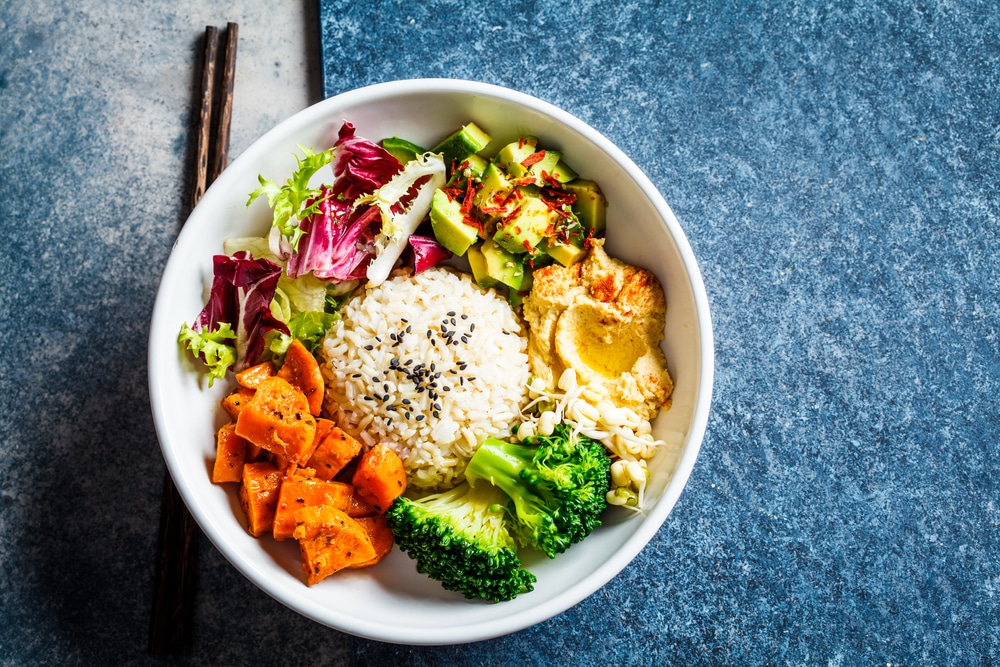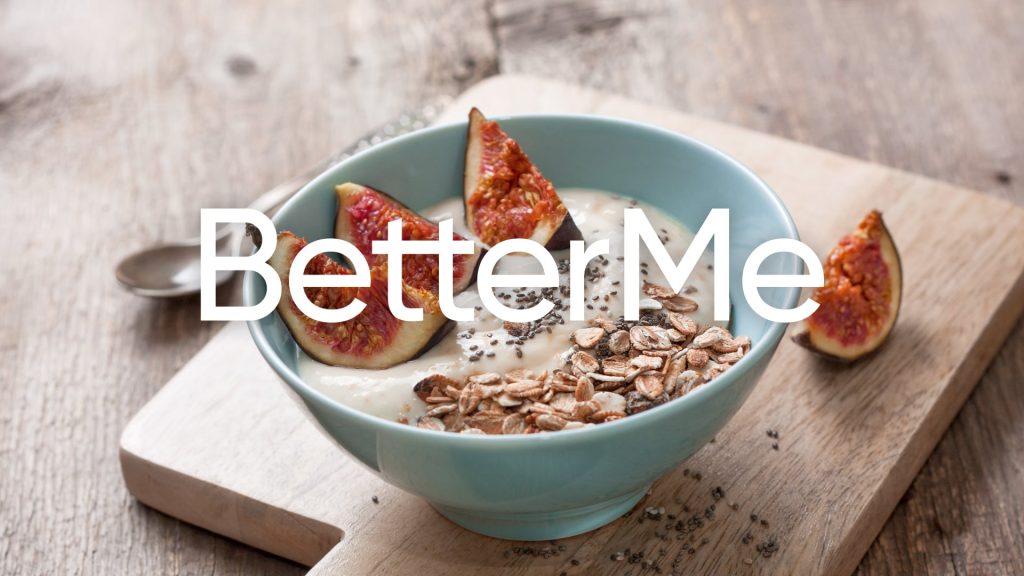The word macrobiotic derives from the Greek words “makros,” meaning “long,” and “bios,” meaning “life.” Simply put, macrobiotics refers to foods that are believed to promote health by balancing a person’s life energy or Qi over time. Macrobiotics was founded in Japan in 1826 by physician Mikao Usui and has become increasingly popular in the US today.
Get your personalized
meal plan!
But what are the benefits of this style of eating? And can anyone benefit from it, or does it only work for certain types of people? Read on to learn a bit about macrobiotic diets and get some recipes that you can use.
What Is The Macrobiotic Diet?
Mikao Usui initially conceived macrobiotics in Japan in 1826 (2). He developed the belief that it is possible to re-balance the Qi within a person’s body by following a diet of whole grains, fish, vegetables, and fruits.
Some followers believe that making positive choices toward one’s eating habits makes it possible to bring more balance into life in general. However, this belief has not been scientifically proven.
The popularity of macrobiotics in the US began during the 1960s because of an interest in the dietary habits of Japanese people during that time. It gained popularity in the 1970s due to a book written by George Ohsawa, an American who studied under a Japanese macrobiotic master (13).
Today’s popular version of the diet includes whole grains, vegetables that grow above ground (such as broccoli), fruits, sea vegetables (dried seaweed such as wakame), beans and other legumes, soy products (such as tofu), and nuts and seeds. This diet is also low in sugar and salt (5).
Read More: Macrobiotic Diet: Balancing Spiritual And Physical Well-Being
 How Do Macrobiotics Work?
How Do Macrobiotics Work?
According to followers of this diet, three main elements contribute to wellness- mind, body, and spirit. When these elements are balanced within a person’s life energy (Qi), it is believed that all illnesses will be cured, and one’s health will improve (4). This belief system has not been scientifically proven; however, some of the concepts of this eating style have been shown to reduce cancer and chronic disease risk, such as eating more fruits, vegetables, and whole grains (11).
The theory behind how the food itself works includes two central beliefs:
- The food is said to be alive, meaning that the food contains life, energy, and consciousness.
- By eating this type of food, it is believed that a person’s life energy will become balanced over time, thus leading to a more healthy lifestyle overall.
 What Can You Eat On A Macrobiotic Diet?
What Can You Eat On A Macrobiotic Diet?
According to those who practice macrobiotics, meat and dairy products are not allowed; however, some debate over whether or not fish can be included in the diet. Some practitioners include fermented foods as well; however, others do not include them because they tend to contain yeast which they believe can stress the digestive tract.
About 40 to 60 % of your daily macrobiotic diet should consist of whole grains (5). Whole grains are the most critical aspect of this diet because they are said to contain more life energy and consciousness than other grains.
Macrobiotic foods include:
- Beans and legumes in any form, such as fresh, dried, or frozen.
- Unmodified whole grains, including brown rice, buckwheat, millet, quinoa, rye, oats, and barley. Sprouted wheat is also acceptable for those who eat it.
- Vegetables that grow above the ground like potatoes, onions, and tomatoes.
- Fruits, including apples, bananas, and pears; however, fruits should be eaten moderately due to their high sugar content. Also, be aware that melons such as watermelons contain a high amount of sugar.
- Vegetables such as broccoli, leeks, seaweed, and potatoes are acceptable for those who eat meat.
- Unsalted nuts and seeds may also be included in the diet as long as they do not have any other added salt or seasonings. Acceptable nuts include almonds, chestnuts, walnuts, and sesame seed; however peanuts should be avoided because they are actually legumes.
- Sea vegetables like kelp can be eaten, but it is essential to remember that some contain high amounts of iodine, so they should only be used sparingly.
 What Can’t Be Eaten On A Macrobiotic Diet?
What Can’t Be Eaten On A Macrobiotic Diet?
Several foods are not allowed on a macrobiotic diet (10). These include:
- Any food made with refined sugar, including fruit juices and soda. Yogurt, honey, and molasses are allowed in moderation as long as the product does not contain any added white sugar.
- Dairy products such as milk, cheese, butter, and eggs. Butter is used sometimes in baking recipes; therefore, it is advised to check the recipe for dairy before making it at home. Cheese should be avoided because of its high-fat content.
- White rice, which has been polished to remove the outer husk, may also be included in the diet; however, brown rice is recommended instead because it contains more nutrients.
- Red meat is not allowed, even in moderation.
- Processed foods are not allowed because they contain a lot of refined sugar and unhealthy fats.
- Alcohol should not be consumed on the macrobiotic diet because it is considered toxic to the body.
Betterme will keep you laser-focused on your weight loss journey! Nutrient-packed meal plans, fat-blasting workouts, galvanizing challenges and much more. Try using the app and see for yourself!
 What Are The Benefits Of The Macrobiotic Diet?
What Are The Benefits Of The Macrobiotic Diet?
Any diet that increases vegetables, decreases sugar and fat, and includes a lean source of protein like fish is good for you in many ways (6).
Healing
Macrobiotics is said to heal the damage done by an improper modern Western diet; however, this statement has not been scientifically proven.
Cleansing
Those who follow this type of diet say that your energy will become less stressed with time, and you will naturally lose weight as a result.
Food Preferences
Some people can break their addiction to sugar and wheat after being on the macrobiotic diet for a while because this type of diet changes your preferences towards food.
Weight Loss
If you follow the diet rules, it is possible to lose weight by excluding unhealthy foods from your diet. If you want to lose more weight, it is recommended that you avoid alcohol and dairy products because they contain a lot of calories; however other natural sugars such as fruit are allowed in moderation.
Read More: 7-Day Workout Plan For Weight Loss To Try Today!
 What Are The Negatives Of A Macrobiotic Diet?
What Are The Negatives Of A Macrobiotic Diet?
There are a few reasons why this diet may not be ideal for all.
- Extreme for most. This type of diet can be extreme for most people. Since it is quite restrictive and can be difficult to follow, it may not be appropriate for everyone.
- Sense of disconnection. Many who have tried this type of diet say that it caused them to feel disconnected from their environment and stressed about food.
- Food sensitivities. Some people will not consume certain grains, such as buckwheat or rye, because of their sensitivity towards these foods.
Can The Macrobiotic Diet Help Treat Chronic Illnesses?
While there’s no absolute proof, medical research suggests diets mainly composed of vegetables, fruits, and whole grains may lower the risk of several diseases (12). Some of the claims made in support of the Macrobiotic diet include:
Diabetes
Since macrobiotics is said to heal the damage done by an improper diet, it has been claimed to help treat diabetic patients. This is because it eliminates the intake of soda and other sugary drinks while encouraging intake of fiber-rich foods (9).
 Epilepsy
Epilepsy
There is currently no systematic evidence that this type of diet can help epileptic patients, but it has been claimed to improve the condition.
Chronic Fatigue Syndrome
A case study showed that a patient with CFS managed their symptoms when they began eating according to the macrobiotic diet. The macrobiotic diet shows promise in reducing fatigue levels in cancer patients because it is anti-inflammatory, just like the Mediterranean diet (7).
3 Easy Macrobiotic Recipes
 Creamy Millet Pudding
Creamy Millet Pudding
However you choose to start your day, it can’t get better than starting it with this one-of-a-kind creamy millet pudding. Packed full of wholesome goodness like millet, bananas, cinnamon (or whatever your favorite seasoning might be), and crunchy nut toppings – there’s no way you can resist how downright tasty this dish is. It’s also protein-packed, with a hearty consistency that everyone will love!
Ingredients:
- 4 cups non-dairy milk (I used 2 cups canned light coconut milk + 2 cups plain unsweetened almond milk)
- ⅔ cup uncooked millet
- ¼ cup agave (or sweetener of choice)
- 1 teaspoon vanilla bean paste (or vanilla extract)
- ½ teaspoon almond extract
- ½ teaspoon cinnamon
- ¼ teaspoon sea salt
For serving: (optional)
- Chopped almonds
- Fresh berries
Instructions:
- Toast the millet in a saucepan over medium-high heat until it starts popping. Be careful not to burn the millet — you want a light toast that’ll come immediately after the millet pops.
- Add all the ingredients into the saucepan, stir to combine.
- Let the mixture boil, and lower the heat to simmer.
- For 20-25 minutes, stir the simmering millet until it’s cooked through.
- Serve in a bowl topped with chopped almonds and fresh berries of your choice.
Recipe courtesy of Creamy Millet Pudding
BetterMe app will kick you out of the mental funk, shake off your extra weight, rid you off your energy-zapping habits, and help you sculpt the body of your dreams. Intrigued? Hurry up and change your life for the better!
 Buckwheat Pilaf (1)
Buckwheat Pilaf (1)
Are you looking for vegan, macrobiotic recipes? Buckwheat pilaf is high in protein, so great for vegetarians looking to add some extra essentials. This winter-worthy pilaf is made from a delicious and warming grain (both in feel and taste!), high in protein, fiber, minerals, and antioxidants, giving it a distinctive flavor.
The crunch of the toasted sunflower seeds complements the satisfying crunch of the onions. The best part? This is one of the macrobiotic recipes in winter that can be altered according to whatever veggies you fancy!
Ingredients:
- 1 cup buckwheat groats
- 1 carrot
- 3 leaves of kale
- 1 tsp sesame oil
- 1 small bunch of spring onions
- Large pinch of sea salt
- 1 tbsp shoyu or tamari
- 1 tsp lemon juice
- 2 cups water
- 1 tsp toasted sesame oil
- ½ cup toasted sunflower seeds
Instructions:
- Rinse buckwheat in cold running water; one rinse should be enough.
- Boil buckwheat in water and salt to taste; cover with the lid and simmer for 20 minutes on low heat.
- Once done, turn off the heat and let the cooked wheat sit for 10 minutes.
- Remove the cover and fluff the rice while adding a little soy sauce.
- Dice the kale and carrots.
- Saute the vegetables in sesame oil.
- Add the buckwheat and stir lightly.
- Toast the sunflower seeds until light golden color.
- Make the dressing by mixing soy sauce, sesame oil, and lemon juice.
- Serve the buckwheat topped with chopped spring onions, toasted sunflower seeds, and the dressing.
Recipe courtesy of The Macrobiotic Association
Succulent Green Pea Soup (8)
If you’re looking for macrobiotic soup recipes that are delicious yet quick to make, this green pea soup is for you. It’s perfect for a hearty lunch and can also be eaten for dinner.
Ingredients:
- 1 small pack of frozen petit pois or garden peas
- ¼ tsp sea salt or to taste
- Fresh ground black pepper
- Organic olive oil to taste
- A squeeze of lemon juice
- Leaves to decorate or to add
Instructions:
- Boil peas in a pot with a cup of water.
- Add salt, pepper, and lemon juice to taste.
- Once cooked, take off the heat and add olive oil.
- Allow it to cool.
- Blend until almost smooth.
- Garnish and serve hot.
Recipe courtesy of The Macrobiotic Association
DISCLAIMER:
This article is intended for general informational purposes only and does not address individual circumstances. It is not a substitute for professional advice or help and should not be relied on to make decisions of any kind. Any action you take upon the information presented in this article is strictly at your own risk and responsibility!
Diets are great, but your body will thank you if you supplement your healthy nutrition plan with a good workout.
SOURCES:
- Buckwheat Pilaf (n.d., macrobiotics.org.uk)
- Celestial Healing: Energy, Mind and Spirit in Traditional Medicines of China (2011, books.google.co.ke)
- Creamy Millet Pudding (Vegan & Gluten-Free Recipe!) (n.d., picklesnhoney.com)
- MACROBIOTIC COOKING (n.d., macrobiotics.org.uk)
- Macrobiotic Diet Plan Review (2020, webmd.com)
- Macrobiotic Health (2015, drweil.com)
- Nutritional interventions for treating cancer-related fatigue: a qualitative review (2020, ncbi.nlm.nih.gov)
- Simple Succulent Green Pea Soup (n.d., macrobiotics.org.uk)
- The effect of the macrobiotic Ma-Pi 2 diet vs. the recommended diet in the management of type 2 diabetes: the randomized controlled MADIAB trial (2014, ncbi.nlm.nih.gov)
- The Macrobiotic Diet (n.d., winchesterhospital.org)
- The Macrobiotic Diet as Treatment for Cancer: Review of the Evidence (2002, ncbi.nlm.nih.gov)
- The macrobiotic diet in chronic disease (2010, pubmed.ncbi.nlm.nih.gov)
- This macrobiotic food guru is the reason you and Gwyneth Paltrow eat like hippies (2017, timeline.com)
















